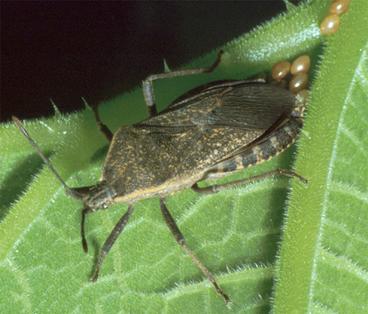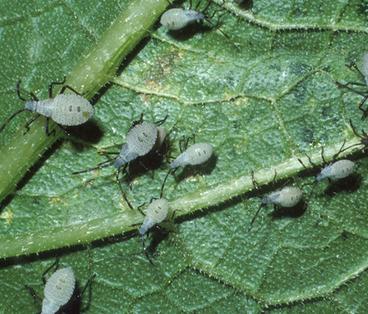Introduction
E.C. Burkness and W.D. Hutchison Department of Entomology, University of Minnesota
The squash bug, Anasa tristis, is common throughout the United States. The squash bug will attack all members of the cucurbit family but are most common on pumpkins and squash. Feeding, via piercing/sucking mouthparts, occurs primarily on the plant foliage. However, late in the season, squash bugs may also feed on fruit. The associated damage symptoms include wilting of leaves and ultimately results in leaves that appear black or dried out.
Biology & Life Cycle
The squash bug can be misidentified as a stinkbug. Both insects look similar and emit a distinct odor when crushed; however, the stinkbug is not a pest of cucurbits and is more commonly associated with tomatoes or various legumes such as soybeans and peas.


Squash bug adults are 5/8 in. long and 1/3 as wide. They are usually gray to black with the edges of the abdomen having orange and brown stripes. Nymphs are 3/16 to 1/2 in. in length. Young nymphs have a red head and legs with a green abdomen, however as the nymphs age the red color will turn to black. Late instar nymphs will be greenish-gray in color with black appendages.
Eggs are 1/16 in. long and have a yellowish brown to brick red color. Eggs are laid individually in groups of about twelve on the underside of leaves (see image, left). Each cluster of eggs is usually laid in a characteristic V shape pattern following the leaf veins. Eggs are laid under the leaves from spring to midsummer and will take 1-2 weeks to hatch. The eggs will become darker as they get close to hatching.
Unmated adults overwinter and find shelter during the early fall under plant debris, around buildings, under rocks, etc; nymphs will die off as temperatures begin to drop. The overwintering adults will emerge in spring and will fly into fields when the plants begin to grow. Mating begins in early spring, and the females lay eggs until midsummer. After eggs hatch, there are five instars taking a total of 4-6 weeks to develop into adults. Nymphs commonly form groups at the base of the plant or under the leaves but are also seen on vines or unripe fruit. They will disperse quickly when disturbed. There is usually a decrease of adults for a period in late summer because of a lag between the death of overwintering adults and the development of new adults from the existing nymphs. There is typically one generation per year in the midwestern U.S.
Damage
Squash bugs feed on cucurbits (vine crops) and prefer squash and pumpkin. Both adults and nymphs cause damage by sucking nutrients from leaves and disrupting the flow of water and nutrients, which can cause wilting. Initially, before wilting, yellow specks will develop on the foliage that eventually turn brown. Under heavy feeding pressure, small plants can be killed; larger plants can have many affected leaves and vines. Subsequent wilting can look similar to bacterial wilt; however, bacterial wilt is a disease spread by striped cucumber beetles and is much more detrimental. Once the squash bug population is reduced, wilted plants should recover. By contrast, plants infected with bacterial wilt will continue to decline and will eventually die. Therefore, it is important to determine which wilt is occurring, and the correct identification of the insect pests present in the field is an essential first step. Squash bugs will also feed directly on the fruit, and it has become an increasing problem in recent years.
Management
Seedlings, new transplants, and flowering plants are the most critical growth stages to monitor, as these are the stages when the most damage can occur. The adult squash bug is difficult to kill, so early detection of nymphs is important.
Cultural Control
Cultural practices such as timing of plantings, variety, and field sanitation practices are important first steps in squash bug management. Preventative measures can be taken to reduce the squash bug population by removing debris located in and around the field. Destroying or removing debris should be done throughout the season and is especially important during the fall to limit overwintering sites for the adults. Using resistant varieties such as Butternut, Royal Acorn, or Sweet Cheese and maintaining a healthy plant through proper fertilization and watering are also important to limiting squash bug damage.
Monitoring & Chemical Control
The threshold for squash bugs is very low. The threshold is reached when the average number of egg masses (meaning groups of eggs) is greater then one egg mass per plant. Control measures should be taken when the threshold is reached or when wilting occurs and the damage is attributed to squash bug, versus other pests or environmental conditions. When plants look wilted, check under the leaves for squash bugs and eggs. If the threshold is exceeded, an insecticide application is warranted. It is most effective to spray just as the eggs are hatching as the small nymphs are more easily controlled. During bloom, sprays should be made early in the morning or later in the evening to reduce the effect of insecticides on honeybees and other pollinators. For the most updated list of insecticide options, and to ensure proper use of insecticides, refer to the most recent edition of the Midwest Vegetable Production Guide. An excellent resource for organic growers is the ATTRA publication, Squash Bug and Squash Vine Borer Control: Organic Control.
References
Cornell University. 2003. Vegetable Disease ID and Management http://vegetablemdonline.ppath.cornell.edu/
Foster, R. & B. Flood. 1995. Vegetable Insect Management. Meister Publishing Co. Willoughby, Ohio.
Hammond, R.B. 1990. Influence of cover crops and tillage on seedcorn maggot (Diptera: Anthomyiidae) populations in soybeans. Environmental Entomology 19: 510-514.
Lam, Frankie. 2004. Managing squash bugs on pumpkins in fall. https://extension.entm.purdue.edu/publications/E-100.pdf
Lyon, W.F., J.A. Neal. 2000. Squash Bug. Ohio State University Fact Sheet.
Metcalf, R.L. & R.A. Metcalf. 1993. Destructive and Useful Insects. 5th Edition. Insects Injurious to Vegetable Gardens and Truck Crops. McGraw-Hill, Inc. New York.
Purdue University. Midwest Vegetable Production Guide for Commercial Growers; https://mwveguide.org/
Sorenson, K.A. and K.A. Kidd. Vegetable Insect Pest Management; Dept. of Entomology. https://entomology.ces.ncsu.edu/
Zitter T.A., D.L. Hopkins, and C.E. Thomas. 1996. Compendium of Cucurbit Diseases. APS Press. St. Paul, Minnesota. pp. 71.